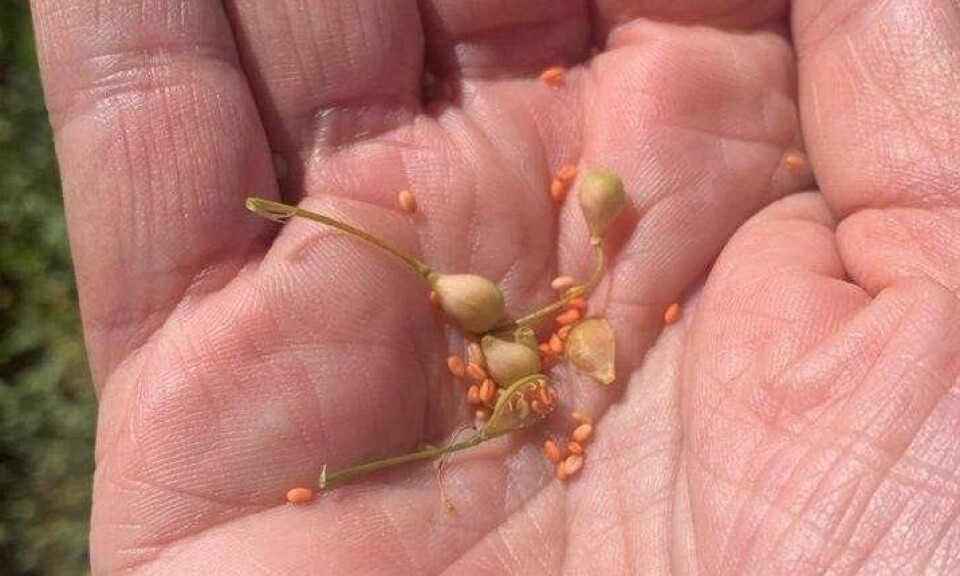
Biotech company seeks green light for ‘drop-in replacement’ to fish oil
Yield10 applies for US approval for crop that produces both DHA and EPA
A US biotech company has applied for regulatory approval for a variety of genetically modified camelina that may provide a “drop-in replacement” for fish oil in salmon feed.
The seeds of the camelina variety are used to produce an oil containing approximately 10% EPA and 10% DHA, the long chain fatty acids in omega-3 that are important for the health of farmed salmon and the consumers who eat the salmon. The fatty acid profile closely resembles the omega-3 EPA/DHA fatty acid profile of northern hemisphere fish oil.
The camelina was developed at Rothamsted agricultural research institute in the UK by Professor Johnathan Napier and his team and is being commercialised by Massachusetts-based Yield10 Bioscience, which has an agreement with Rothamsted.
In October last year, salmon feed producer BioMar signed an agreement with Yield10 to form a long-term partnership to commercialise the crop.
An ideal platform
“Based on the scientific work published by the Rothamsted Institute, including salmon feeding and human clinical trials, we believe the camelina omega-3 technology represents an ideal platform for the sustainable, land-based production of high value omega-3 oils to address the significant potential opportunity in the global aquafeed and human nutrition markets,” said Yield10 chief science officer Kristi Snell this week.
“We believe camelina-based production of omega-3 oil containing EPA and DHA is a promising solution to address the ongoing shortfalls in supply of omega-3 oil from fish oil and sustainably meet the projected increase in global demand for omega-3 oil in the years to come. We are focused on advancing our omega-3 oil producing camelina along the regulatory path, building seed inventory and engaging with potential commercial partners.”
Yield10 initially applied for product authorisation in the United States with a camelina that produces EPA and has now followed that up with the variety producing both EPA and DHA. The company currently has 50 acres of EPA-producing camelina growing in Chile to begin the ramp-up of seed inventory for future planting, as well as to produce omega-3 (EPA) oil samples for business development activities.
It is now scaling up a camelina line to produce oil containing both EPA and DHA fatty acids.
Extensively tested
“This line has been extensively tested by Rothamsted and published aquafeed studies have shown that the EPA + DHA oil produced in camelina has the potential to serve as a drop-in replacement for fish oil. Furthermore, published human clinical studies have shown this oil to be an effective alternative to fish oil in the human diet,” said Yield10 in a press release.
Genetically modified (GM) products are not currently allowed in Scotland, but an omega-3 fish feed ingredient derived from genetically modified canola became the first GM product to be approved for use in Norway in June last year.
Australian-owned Nuseed won approval for its Aquaterra oil after Norway’s Science Committee for Food and Environment (VKM) carried out a risk assessment of the product for use in fish feed on behalf of the Norwegian Food Safety Authority (Matillsynet).
No increased risk
The committee concluded that fish feed containing the oil does not pose an increased health risk for fish or have any indications of increased environmental risk compared to conventional fish feed with oils from other sources.
Nuseed already has approvals for Aquaterra use in the United States, Canada, and Australia, and Aquaterra was commercially launched for use in Chilean salmon production in 2020. The company is also seeking approval for Aquaterra for animal feed uses in the European Union and UK.
Napier believes the camelina created by Rothamsted has superior composition, since its oil accumulates both EPA and DHA to around 10% each, whereas Nuseed’s canola products primarily accumulates only DHA.
“We might be late to the party but we’re the one that's turning up with the champagne,” he told Fish Farming Expert last year.






















































